Thuja occidentalis Golden Globe, description and photo, planting and care, use in landscape design
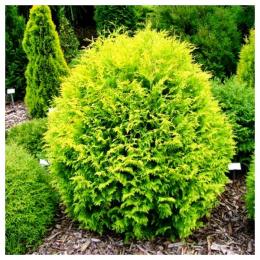
An exquisite plant, Thuja occidentalis Golden Globe is so tiny that there is sure to be a place for it in any garden.
This green-yellow spherical bush, the exact color of the needles, will enliven the garden landscape even on the stormiest day.
Content:
- Thuja occidentalis Golden Globe, description, dimensions, photos
- Landing rules
- Features of caring for thuja occidentalis Golden Globe
- Pests and diseases and their control
- How to organize wintering of thuja occidentalis Golden Globe
- Thuja occidentalis Golden Globe, haircut, pruning
- Application in landscape design
Description of the plant
We have already mentioned that the shape of the Golden Globe thuja is spherical. Belongs to the evergreens. It grows very slowly, at the age of ten it can reach up to 80 cm in height and width. Gives a maximum of 8-10 cm of growth per year.
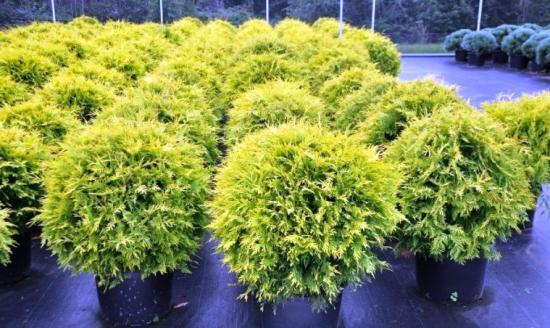
The maximum height of an adult specimen will not exceed 1.2 m.
The colors of the shoots are very original, it’s not difficult to notice in the photo. Provided there is sufficient sunlight, their tips acquire a bright yellow color, while the needles inside the ball remain bright green.
In autumn, the plant changes color to copper, and with the onset of spring warmth it restores its golden color.
The shape of the thuja shoots is straight, flat, they are placed very tightly, and they grow evenly to the sides.
The plant has superficial roots that are sensitive to soil density.
To admire the dense golden bush, it is recommended to plant the thuja occidentalis Golden Globe in areas exposed to the sun; with strong shade, it acquires a bright green color, and the bushes become less crowded.
Let's watch a video about Thuja occidentalis Golden Globe:
Thuja occidentalis Golden Globe, planting rules
There is no need to worry too much about the choice of soil for planting; the plant, in principle, is not demanding of it. If we talk about the ideal option, then these are fertile loams without stagnation of water. Acidic or alkaline soil does not play a special role.
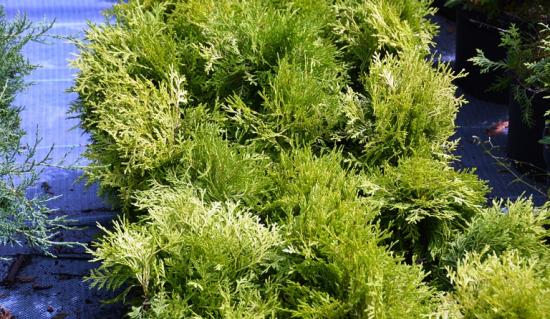
The plant should not experience a lack of moisture, but its excess can be destructive.
So, choose a well-lit place for planting.
Before planting from the container, the plants are well filled with water.
To guess the size of the planting hole, you can measure the diameter of the container in which you purchased the plant. The hole should be one and a half, or even twice as large.
If the area is low-lying, then it is necessary to arrange drainage: the hole is dug about 20 cm deeper and first filled with a 20 cm layer of expanded clay or gravel.
To fill the planting hole, use the soil removed from it; it should be thoroughly mixed with peat, ratio 1:1. Also, mineral fertilizers are added to the peat-soil mixture; it is better to give preference to complex ones; for each liter of the mixture you will need about 5 grams. This composition will significantly speed up the process of growth of the root system.
When planting, the crown neck of the bush should not be deepened; it should be at ground level.
Immediately after planting, water the plant with plenty of water. the tree trunk circle is mulched. You can use either peat or bark as mulch. Note that the plant covered with bark looks quite decorative.
As for planting dates, potted plants purchased at garden centers can be planted throughout spring, summer and autumn.
They take root well, provided they are properly cared for. In addition, garden centers use long-acting fertilizers, which allows you to do without additional fertilizing in the first year after planting the thuja.
Features of caring for thuja occidentalis Golden Globe
A newly planted plant, which is quite natural, at first needs systematic watering. It is difficult to indicate their number; it all depends on the frequency of natural precipitation in your area.
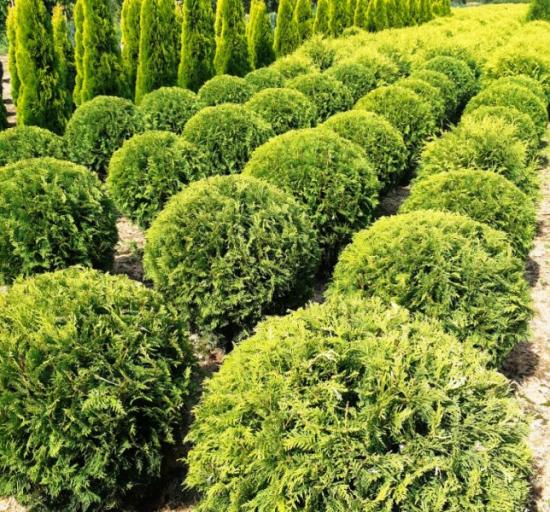
But during the dry period you will need at least 1 watering per week, the amount of water is a bucket.
Mulching will help reduce moisture evaporation; the layer thickness should be about 5-8 cm.
A signal that the plant requires additional watering will be when the soil under the bush dries out.
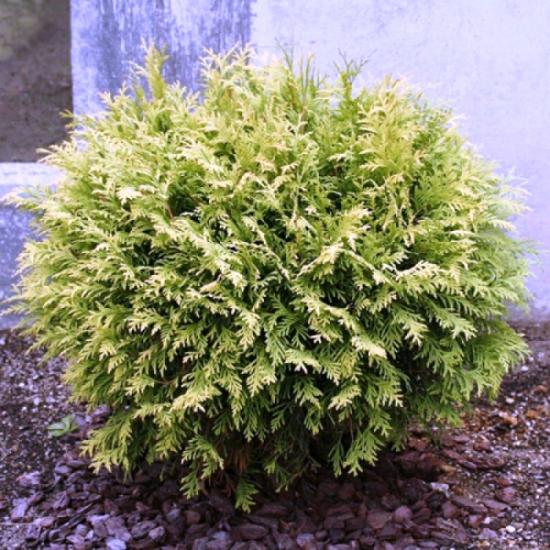
In the spring, when the plants awaken, the thuja also needs additional watering and feeding. Usually nitroammophoska or complex fertilizers are applied in an amount of 30-40 g per square meter of area. Potassium-containing fertilizers are used for autumn fertilizing.
Pests and diseases, their control
Most often, Golden Globe thuja is affected by fungal diseases.
Preventive treatments will help prevent their occurrence:
- with the onset of April - Bordeaux mixture 1 percent:
- when signs of disease appear, use fungicides Topsin, Hom, Skor, Maxim, Quadris, Radomil Gold.
How to organize wintering of thuja occidentalis Golden Globe
The plant has a climatic frost resistance zone 5 A and is suitable for growing in open ground in the conditions of the Middle Zone.
Although the variety is classified as frost-resistant, plants often suffer from needle burn. It occurs from exposure to too bright sun at a time when the soil has not yet completely thawed. Young plants usually suffer from burns.
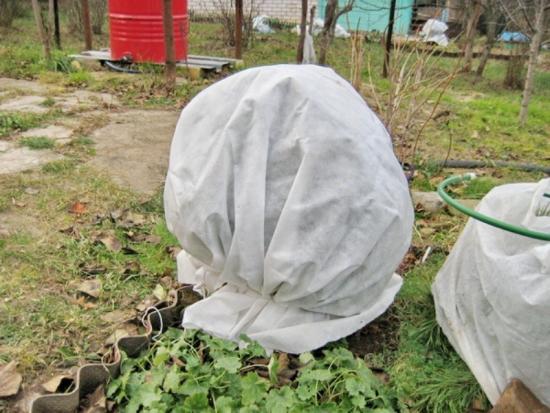
To prevent a possible problem, it is recommended to shade the plants in the second half of winter using spruce spruce branches and agrofibre. It is removed only after the soil has completely melted.
It is best if the plants are opened not on a sunny day, but on a quiet, cloudy day. This makes it much easier for them to adapt to the new season.
In areas where winters are especially harsh, it is recommended to wrap the plants in the fall for the first year using loose burlap or agrofibre.
Thuja occidentalis Golden Globe, how to prune
Since the natural shape of the plant is quite attractive, formative pruning will not be required.
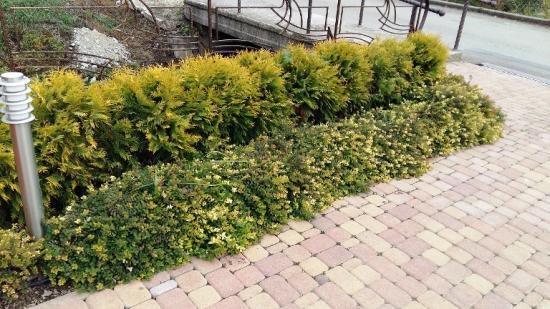
Sanitary pruning is carried out in early spring; it consists of carefully removing dried shoots.
If it is necessary to trim a hedge, then cut off no more than one third of the shoot; crown shaping is performed as necessary.
Let's watch a video about pruning a plant:
Application in landscape design
Thuja occidentalis Golden Globe is ideal for small areas.
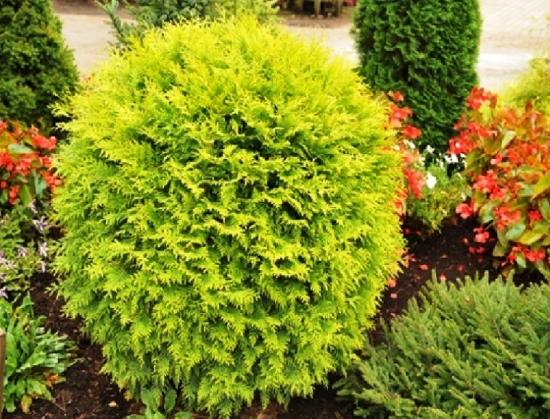
She can land:
- like a free-growing hedge;
- as a tapeworm on the lawn;
- next to beautiful flowering plants in mixborders.
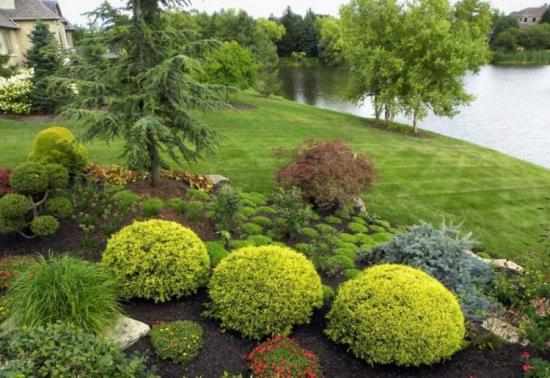
In city street conditions, the plant is planted along the facades of buildings and borders, as single or group plantings on lawns, along park and garden paths, and in flower arrangements.
Let's watch another video about this attractive plant:

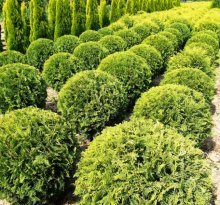

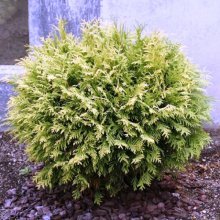
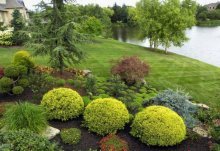
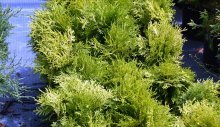
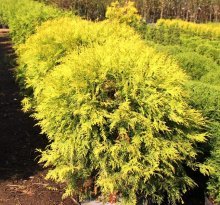

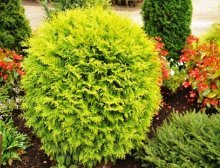
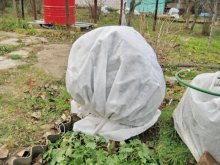
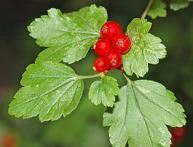
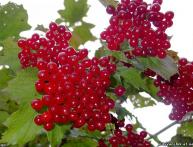



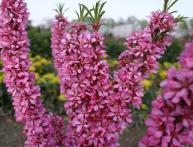
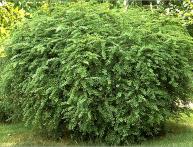
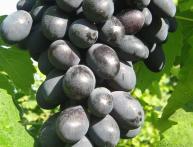
Comments
I generally adore any thuja, this species, as I understand it, is very prone to the formation of fungal diseases and prevention should be carried out regardless of whether the plant is affected or not? Right?
I have never seen a thuja with such an unusual shape. They usually grow in the shape of a cone, varying in height. Alternating conical and spherical thuja in fencing any area will be very beautiful and pruning will not be required at all.
Thuja, of course, looks very beautiful in the front garden and it is unlikely that any other plant will replace it. It doesn’t require much care; for the winter I wrap it in cellophane, since this place can be exposed to wind during particularly cold winters.